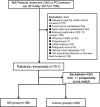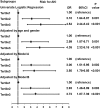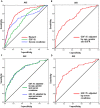Growth differentiation factor-15 levels and the risk of contrast induced acute kidney injury in acute myocardial infarction patients treated invasively: A propensity-score match analysis
- PMID: 29529072
- PMCID: PMC5846798
- DOI: 10.1371/journal.pone.0194152
Growth differentiation factor-15 levels and the risk of contrast induced acute kidney injury in acute myocardial infarction patients treated invasively: A propensity-score match analysis
Abstract
Background: Growth differentiation factor-15 (GDF-15) is an emerging biomarker for risk stratification in cardiovascular disease. Contrast-induced acute kidney injury (AKI) is an important complication in patients undergoing coronary angiography (CAG) or percutaneous coronary intervention (PCI). In this retrospectively observational study, we aimed to determine the role of GDF-15 and the risk of AKI in acute myocardial infarction (AMI) patients.
Methods: The medical records of 1195 patients with AMI were reviewed. After exclusion criteria, a total of 751 eligible patients who underwent CAG or PCI were studied. Preoperative clinical parameters including GDF-15 levels were recorded. Multivariate logistic regression analysis was used to identify the risk factors of AKI. Subsequently, to reduce a potential selection bias and to balance differences between the two groups, a propensity score-matched analysis was performed. We recorded the 30-day all-cause mortality of the total study population. Kaplan-Meier analysis was performed to identify the association between short term survival in AMI patients and GDF-15 level.
Results: Among 751 enrolled patients, 106 patients (14.1%) developed AKI. Patients were divided into two groups: AKI group (n = 106) and non-AKI group (n = 645). GDF-15 levels were significantly higher in AKI group compared to non-AKI group (1328.2 ± 349.7 ng/L vs. 1113.0 ± 371.3 ng/L, P <0.001). Multivariate logistic regression analyses showed GDF-15 was an independent risk factor of AKI (per 1000 ng/L increase of GDF-15, OR: 3.740, 95% CI: 1.940-7.207, P < 0.001). According to GDF-15 tertiles, patients were divided into three groups. Patients in middle (OR 2.93, 95% CI: 1.46-5.89, P = 0.003) and highest GDF-15 tertile (OR 3.72, 95% CI: 1.87-7.39, P <0.001) had higher risk of AKI compared to patients in the lowest GDF-15 tertile. The propensity score-matched group set comprised of 212 patients. Multivariate logistic regression revealed that GDF-15 is still an independent risk factor for AKI after matching (per 1000 ng/L increase of GDF-15, OR: 2.395, 95% CI: 1.020-5.626, P = 0.045). Based on the Kaplan-Meier analysis, the risk of 30-day all-cause mortality increased in higher GDF-15 tertiles log rank chi-square: 29.895, P <0.001).
Conclusion: This suggests that preoperative plasma GDF-15 is an independent risk factor of AKI in AMI patients underwent CAG or PCI. GDF-15 and AKI are associated with poor short term survival of AMI patients.
Conflict of interest statement
Figures





References
-
- Giacoppo D, Madhavan MV, Baber U, Warren J, Bansilal S, Witzenbichler B, et al. Impact of Contrast-Induced Acute Kidney Injury After Percutaneous Coronary Intervention on Short- and Long-Term Outcomes: Pooled Analysis From the HORIZONS-AMI and ACUITY Trials. Circulation Cardiovascular interventions. 2015;8(8):e002475 Epub 2015/07/23. doi: 10.1161/CIRCINTERVENTIONS.114.002475 . - DOI - PubMed
-
- Narula A, Mehran R, Weisz G, Dangas GD, Yu J, Genereux P, et al. Contrast-induced acute kidney injury after primary percutaneous coronary intervention: results from the HORIZONS-AMI substudy. European heart journal. 2014;35(23):1533–40. Epub 2014/03/08. doi: 10.1093/eurheartj/ehu063 . - DOI - PubMed
-
- Fox CS, Muntner P, Chen AY, Alexander KP, Roe MT, Wiviott SD. Short-term outcomes of acute myocardial infarction in patients with acute kidney injury: a report from the national cardiovascular data registry. Circulation. 2012;125(3):497–504. Epub 2011/12/20. doi: 10.1161/CIRCULATIONAHA.111.039909 ; PubMed Central PMCID: PMC3411118. - DOI - PMC - PubMed
-
- Gaffney AM, Sladen RN. Acute kidney injury in cardiac surgery. Current opinion in anaesthesiology. 2015;28(1):50–9. Epub 2014/12/09. doi: 10.1097/ACO.0000000000000154 . - DOI - PubMed
-
- Bellomo R, Auriemma S, Fabbri A, D'Onofrio A, Katz N, McCullough PA, et al. The pathophysiology of cardiac surgery-associated acute kidney injury (CSA-AKI). The International journal of artificial organs. 2008;31(2):166–78. Epub 2008/03/04. . - PubMed
Publication types
MeSH terms
Substances
LinkOut - more resources
Full Text Sources
Other Literature Sources
Medical
Research Materials
Miscellaneous

